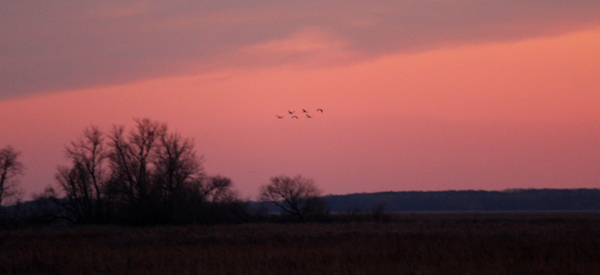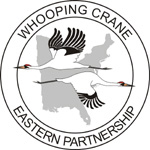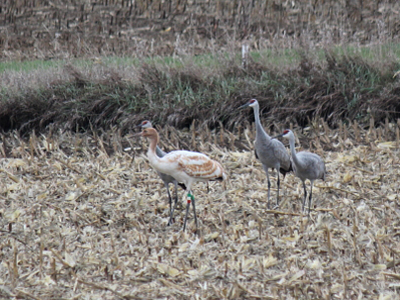
 |
Share this video with your friends and help us spread the word that disturbing, harassing or killing Whooping Cranes is a crime. |
 Report a Whooping Crane sighting Report a Whooping Crane sighting |
 Make a gift to support Whooping Crane conservation. Make a gift to support Whooping Crane conservation. |
Media Contact: Joan Garland, ICF Outreach Coordinator, 608-381-1262
Where are they now? As of November 6th, no. 14-12 (a.k.a. Lily) remains with Sandhill Cranes near Horicon. The other five cranes left Wisconsin on October 31st and were tracked through Illinois to Indiana, past Kentucky and on to…Visit our Facebook Page for updates on the migration and the cranes’ current locations!
Six young Whooping Cranes were released Monday at Horicon National Wildlife Refuge (NWR) in Dodge County, Wis. The cranes are part of the Direct Autumn Release (DAR) project conducted by the Whooping Crane Eastern Partnership (WCEP), an international coalition of public and private organizations that is reintroducing this highly imperiled species in eastern North America, part of its historic range. There are now 110 Whooping Cranes in the wild in eastern North America thanks to WCEP’s efforts.
The DAR cranes were hatched and raised by biologists with WCEP partner International Crane Foundation (ICF) – click here to learn more and view video of the chicks at ICF this spring. The six birds were released in the company of older cranes from whom the young birds will learn the migration route south.
“Everyone at ICF is happy to see these birds released. 2012 has been a challenging year – ICF’s aviculture and veterinary staff has worked tremendously hard to get these six cranes into the field and are to be congratulated,” said Dr. Barry Hartup, Director of Veterinary Services at ICF. “Of course, we couldn’t accomplish this without all of the generous support of individuals and foundations committed to the recovery of this iconic species – thank you.”
Biologists from ICF are tracking the released cranes using radio and satellite telemetry, picking up signals emitted from leg transmitters on the birds.

In addition to the six DAR birds, five juvenile Whooping Cranes are being led south by project partner Operation Migration’s ultralight aircraft. The cranes left the White River Marsh State Wildlife Area in Green Lake County, Wis. on September 28. The ultralight-led birds are currently in Piatt County, Illinois. The ultralight-led and DAR chicks this year are joining two wild-hatched chicks in the 2012 cohort.
Whooping Cranes were on the verge of extinction in the 1940s. Today, there are only about 600 birds in existence, approximately 445 of them in the wild. Aside from the WCEP birds, the only other migratory population of Whooping Cranes nests at Wood Buffalo National Park in northern Alberta, Canada and winters at Aransas NWR on the Texas Gulf Coast. A non-migratory flock of approximately 20 birds lives year-round in the central Florida Kissimmee region, and an additional 14 non-migratory cranes live in southern Louisiana.
WCEP asks anyone who encounters a Whooping Crane in the wild to please give them the respect and distance they need. Do not approach birds on foot within 200 yards; remain in your vehicle; do not approach in a vehicle any closer than 100 yards. Also, please remain concealed and do not speak loudly enough that the birds can hear you. Finally, do not trespass on private property in an attempt to view or photograph whooping cranes.
Whooping Crane Eastern Partnership founding members are the International Crane Foundation, Operation Migration, Inc., Wisconsin Department of Natural Resources, U.S. Fish and Wildlife Service, the U.S. Geological Survey’s Patuxent Wildlife Research Center and National Wildlife Health Center, the National Fish and Wildlife Foundation, the Natural Resources Foundation of Wisconsin, and the International Whooping Crane Recovery Team.
Many other flyway states, provinces, private individuals and conservation groups have joined forces with and support WCEP by donating resources, funding and personnel. More than 60 percent of the project’s budget comes from private sources in the form of grants, public donations and corporate sponsors.
